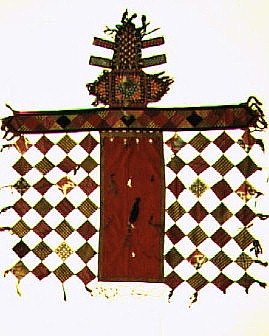sprice@hsc.vcu.edu
Dear People, The first picture in Stephen's Salon introduction shows the
bridal camel in a wedding procession. It's all decked out with an asmalyk
on the flank, a kejebe on the top in which the bride is presumably
concealed, and a trapping that covers the top of its head and comes down
the neck. This is an image of such a trapping:  It's a sort of a patchwork
affair, with squares of embroidery, what appears to be Uzbek ikat, and
some velvet fragments sewn together at their corners to hang down
alongside the animal's neck. This construction is typical of the ones I've
seen. The same is true of the locks of hair that are attached to the
largest piece. I have no idea what significance the hair has; it appears
to be human. I thought some of our readers might be interested in the
image; these things don't show up in most books. Steve
Price It's a sort of a patchwork
affair, with squares of embroidery, what appears to be Uzbek ikat, and
some velvet fragments sewn together at their corners to hang down
alongside the animal's neck. This construction is typical of the ones I've
seen. The same is true of the locks of hair that are attached to the
largest piece. I have no idea what significance the hair has; it appears
to be human. I thought some of our readers might be interested in the
image; these things don't show up in most books. Steve
Price |
 It's a sort of a patchwork
affair, with squares of embroidery, what appears to be Uzbek ikat, and
some velvet fragments sewn together at their corners to hang down
alongside the animal's neck. This construction is typical of the ones I've
seen. The same is true of the locks of hair that are attached to the
largest piece. I have no idea what significance the hair has; it appears
to be human. I thought some of our readers might be interested in the
image; these things don't show up in most books. Steve
Price
It's a sort of a patchwork
affair, with squares of embroidery, what appears to be Uzbek ikat, and
some velvet fragments sewn together at their corners to hang down
alongside the animal's neck. This construction is typical of the ones I've
seen. The same is true of the locks of hair that are attached to the
largest piece. I have no idea what significance the hair has; it appears
to be human. I thought some of our readers might be interested in the
image; these things don't show up in most books. Steve
Price